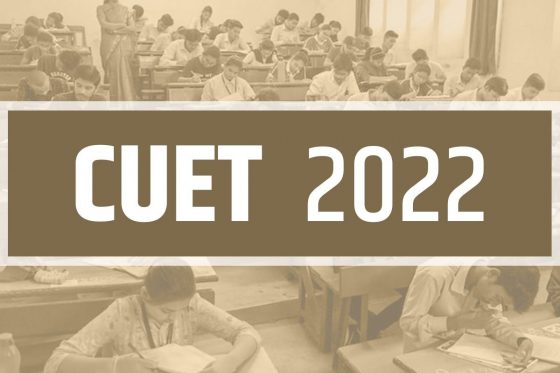Finally, the wait is over. The dates for the first ever CUET for admission to various UG programmes have been released. The next 3-4 weeks will be very crucial for your academic career. If we want to draw a parallel to any other exams, the score of CUET is as important as that of JEE or NEET in shaping your career. In a way, you can take it lightly. In JEE or NEET, one spends a full two years preparing for that too, under the guidance of professional coaching institutes.
CUET, being the first time programme, has not given that luxury to prepare for long and under the tutelage of a professional expert.
In this series of articles, we shall bring out the best preparation strategies for three of the following areas separately:
1. Language tests (Section 1) (1A and 1B put together)
2. Domain Specific Tests (Section 2) : Arts/Humanities, Commerce and Science
3. General Test (Section 3): General Knowledge and Current affairs, General Ability, Numerical Ability, Quantitative Reasoning and Logical & Analytical Reasoning.
Before we start, let’s have a quick look at the CUET 2022 exam dates such that we understand what our schedule should be in each area and how we should develop our strategy of preparation. CUET 2022 exam dates are scheduled between July 15 and August 10 over a window of 10 days and two slots.
The National Testing Agency will conduct the CUET 2022 exam on July 15th, 16th, 19th, 20th July and August 4th, 5th, 6th, 7th, 8th, and 10th, 2022 in two slots every day. NTA will release CUET Admit Card 22022 prior to a week of the CUET 2022 examination.
The candidates can frequently visit the website to get all the updates on CUET 2022.
CUET 2022 DATE:
| Detail | Statistics |
| CUET Exam Dates 2022 | 15th, 16th, 19th and 20th July 20224th, 5th, 6th, 7th, 8th and 10th August 2022. |
| CUET Exam Modes | Computer-Based Test |
| Exam Cities/Centres | 554 Cities within India, 13 Cities Outside India |
| Institutes/Universities Participating in the CUET | 44 Central Universities13 State Universities12 Deemed Universities18 Private Universities |
| CUET 2022 Slot | CUET 2022 Timing |
| Slot 1 | 9 am to 12.15 pm |
| Slot 2 | 3 pm to 6.45 pm |
Today, in this article we shall discuss how you should prepare for the Language Test(s) and maximise the score.
LANGUAGE TESTS (SECTION 1):
A language test is compulsory for all. Hence, its importance cannot be overstated. This has been further divided into sub-sections 1A and 1B. One may attempt a maximum of 3 tests (out of the 33 subjects) from Section 1 (1A and 1B put together).
1A: There are 13 languages (Assamese, Bengali, English, Gujarati, Hindi, Kannada, Malayalam, Marathi, Odia, Punjabi, Tamil, Telugu and Urdu) in 1A.
1B: It has 20 languages: Arabic, Bodo, Chinese, Dogri, French, German, Italian, Japanese, Kashmiri, Konkani, Maithili, Manipuri, Nepali, Persian, Russian, Sanskrit, Santhali, Sindhi, Spanish and Tibetan.
Note that subject, one of the languages, can be chosen as the domain-specific subject.
In Section 1 A & 1B, the students will be asked to attempt 40 of the given 50 questions in each subject in 45 minutes (for each language). In each subject (irrespective of the language chosen), questions would be based on Reading Comprehension (RC), Vocabulary, Antonyms & Synonyms, Choosing the Correct Word, Verbal Ability, Rearranging the Parts (of a passage or sentence).
Most reading comprehension questions would be based especially on narrative, literary and factual passages. Therefore, the students should possess excellent reading and understanding skills to ace this section.
- Maximum marks: 200 (5 marks per question), Negative Marking: 1 mark per incorrect answer.
- No marks will be awarded/deducted for leaving a question un-attempted.
PREPARATION TIPS FOR LANGUAGE TESTS (SECTION 1)
My advice to candidates will be to revise basic concepts of grammar like Nouns, Active-Passive Voice, Synonyms, Antonyms, etc in order to understand the questions more clearly and answer better (assuming that English will be chosen by the highest number of students). If it is another language, then similar things in that language should be practised.
Comprehension-based questions are questions that are often asked. The clarity in the concepts of grammar helps improve comprehension. Practice comprehension and writing skills under a strict timer to test their speed and accuracy. My advice to the aspirants will be:
a. Do not overlook the importance of Language (Section-1) over other subjects/papers, since it is scoring and can easily advance your overall percentage.
b. You can expect 6-8 reading comprehension of around 400 words.
c. Since passages are expected to be narrative, literary and factual, a lot of fact-based questions from the given information may be expected.
Importance of Verbal Ability
Verbal ability is nothing but the basic ability of a student who can explain his/her thoughts and ideas clearly with the help of appropriate words and well-constructed sentences in order to make others understand what he/she wants to express.
It is a very critical component in any competitive exam. To master this part, excellent sentence-forming skills and vocabulary are important. The most vital part of this section is the reading ability of passages, sentences, instructions etc. So, start reading from day one of your preparation phase.
Try to read novels and magazines for at least 30 minutes each day and note down the complicated words followed by writing their meanings.
It is important to note that to have a good hold on your verbal ability, you need to develop the following:
1) Comprehension
2) Appropriate Vocabulary
3) Correct grammatical expression.
1. READING COMPREHENSION- UNDERSTANDING AND INTERPRETATION SKILLS ARE FUNDAMENTAL
Understanding and interpretation skills are fundamental to score marks in the reading comprehension section. You must go through editorial parts in newspapers and several novels in order to master reading skills.
What you read and what connections you draw depends on how you read and comprehend in a short time. A critical eye is important to determine what logic you will be using to answer the questions that follow.
Examine how the author has built the passage logically by using cause and effect reasoning, model construction, hypothesis, deduction or induction, giving analogy & example, negation technique etc.
Follow the tips given below for the reading comprehension section to understand what is given effectively:
i. First, try to understand the paragraph construction. A passage largely consists of an introduction (beginning part), a body (may comprise two or three paragraphs), and a conclusion (the last part).
ii. The introductory paragraph is very important as it throws light as to what is the main idea of the passage and also sets the tone of the passage. The answer of the implicit or inferential questions must be in line with the main idea of the passage and also set the tone of the passage set in the introduction.
iii. The body of the passage will contain all the details that elaborate the scope and justify the author’s main points. These paragraphs bring out the pros and cons and answers to most of the fact-based questions would be found here.
iv. Finally, a conclusion paragraph is given to help draw a summary of the whole thing. In case you have less time to read the whole passage meticulously, you must read the first and the last paragraphs and can use elimination techniques based on the understanding of these two.
v. Identify the keywords while reading the questions and come back to the passage quickly to locate them. You can use the technique of mind mapping.
vi. Try to anticipate and make predictions. You can start by anticipating what the next ideas of the author will be and make inquiries with yourself. If it turns out to be right, it will help you answer an implicit question easily. However, if your thing goes wrong, you can promptly correct it.
2. CONCENTRATE ON VOCABULARY BUILDING
Any Aptitude Test aims to complete a rigorous evaluation of the mental faculties: the skills such as the skills of analysis and comprehension, powers of logic, deduction and capacity to arrive at a correct decision under severe time constraints are the ones that go into building a pool of human resources that become the team of an organisation which would last the test of time.
From a test takers’ perspective, a harmonious blend of speed, accuracy and precision is required to meet this formidable challenge. A good repertoire of vocabulary is also required to develop the above-mentioned skills.
The knowledge of words in their isolated identity, without overlooking their connotation, is tested in the form of synonyms, antonyms, one-word substitutions, analogies, etc. The choice provided may be narrowed down to two, but the final answer needs you to know the word exactly.
Vocabulary questions in an Aptitude Test also primarily focus on aptitude and comprehension. Bear in mind that to choose the correct one from the two closed options will require a real feel for words. The choice of the correct alternative may depend as much on the meaning of the words as on the grammatical appropriateness (part of speech etc) of the word.
CONCENTRATE ON THE FOLLOWING THINGS WHILE PRACTICING VOCABULARY:
i. A synonym or an antonym of a word should be on the same part of speech in the option choices as that of the given word in the question.
ii. Learn odd words, spellings, same sounding words with different spellings, One word with different meanings,
iii. Learn sentence completion, contextual vocabulary, punctuation, etc.
In addition to the above, you should also work on idioms and phrasal verbs- many struggle with that. To understand the usage of a word in a certain place, you should first comprehend its context as its genesis.
3. CORRECT USAGE OF GRAMMATICAL EXPRESSIONS COMES FROM READING
1. Subject-verb agreement in a sentence is the most important thing:
Choosing a subject and its verb and their agreement is the primary condition of a sentence construction. The rest are all secondary to these two elements of a sentence. Learn the difference between countable and uncountable (non-count) nouns.
2. Punctuation mark is important
It sounds simple but, in fact, it is extremely intricate. So pay attention to a few thumb rules for punctuation. For example, always use a comma after introductory phrases or prepositional phrases. Also, learn when to use commas while using relative pronouns. Relative pronouns introduce relative clauses.
The most common relative pronouns are who, whom, whose, which, that. We use relative pronouns depending on what we are referring to and the type of relative clause. It is through the use of the comma that we know if the relative pronoun is introducing a defining or a non-defining clause.
So use a comma to separate the words that, who, and which. But do this only if the phrase contains nonessential information that could be omitted from the sentence without the sentence losing its basic meaning.
A semicolon is also as important as a comma. It can separate two sentences or independent clauses within a complex sentence. Semicolons are often found in fiction written in English.
Similarly, understand the concept of ‘appositive’ in a sentence. In short, an appositive is a noun or pronoun set beside another noun or pronoun to explain or identify it. The appositives are also separated from the noun or pronoun by a comma to add extra information.
3. While using pronouns, you must take care of:
1. Cases of pronouns
2. Agreement of a pronoun with its antecedent
4. Understand the articles
In the English language, there are two kinds of articles, definite (the) and indefinite (a/an). Remember that a/an is used when referring to something in general, and when referring to something specific. To understand where an indefinite article is essential, the concept of countable & uncountable nouns must be learnt. For the use of definite articles, the set rules to be learnt.
5. Be careful with modifiers
Modifiers are words that describe and change your impression of something. That is, they modify the way other words are perceived or understood by adding more descriptive information. The following types of Modifier Errors may occur.
- Misplaced Modifiers
- Squinting Modifiers
- Adverb / Adjective Errors
- Dangling Modifiers
Just remember that the way pronouns have antecedents to which they must clearly point “back”, modifiers must also clearly point to one or more words as their subject.
6. Tense consistency and parallelism maybe problematic
Verb tense consistency refers to keeping the same tense throughout a clause. We don’t want to have one time period being described in two different tenses, except in direct speech.
Parallel structure (also called parallelism) in a sentence is the repetition of a chosen grammatical form within a sentence. A parallel construction requires each compared item or idea in a sentence to follow the same grammatical pattern. For example, if there are three objects added to a verb in a sentence, each should be either noun or gerund or infinitive. We can’t mix them in a different way.
7. Sentences must use words/phrases that are Idiomatic
Certain words or phrases are written in a certain way only. Even if you don’t know why, you must remember their use in that way only. For example, after ‘look forward to’ or ‘in a view to’ we always use a gerund form, even though we usually use an infinitive after ‘to’. Again, we use ‘agree to’ and ‘agree with’ in different contexts.
Authored by Falguni Goswami, founder and Director of Careerbandhu Education.



































